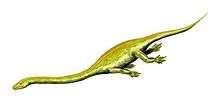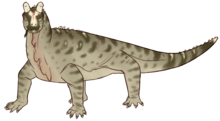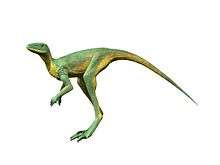Diodorus scytobrachion
Diodorus is a genus of silesaurid dinosauriforms (relatives of basal dinosaurs) from the Late Triassic (Carnian - Norian) Timezgadiouine Formation of the Argana Basin of Morocco. It is named after Diodorus, a legendary king of the Berber people and son of Sufax, the founder of Tangier and also in honour of Diodorus Siculus, a 1st-century Greek historian who wrote about North Africa. The specific epithet, scytobrachion, is ancient Greek for "leather armed", but also honors Dionysius Scytobrachion, a mythographer who chronicled the mythical history of North Africa. The holotype and all referred remains were found in a single quarry at the base of the Irohalene Mudstone Member of the Timezgadiouine Formation in the northeastern Argana Basin, 2.9 kilometres (1.8 mi) east of Imziln, Morocco.
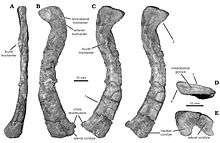
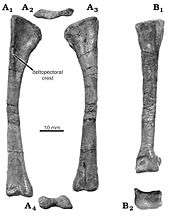
| Diodorus scytobrachion | |
|---|---|
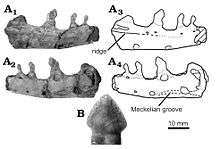 | |
| Dentary and tooth | |
| Scientific classification | |
| Kingdom: | Animalia |
| Phylum: | Chordata |
| Clade: | †Silesauridae |
| Clade: | †Sulcimentisauria |
| Genus: | †Diodorus Kammerer, Nesbitt, & Shubin, 2012 |
| Species: | †D. scytobrachion |
| Binomial name | |
| †Diodorus scytobrachion Kammerer, Nesbitt, & Shubin, 2012 | |
Diodorus can be distinguished from other silesaurids by the presence of forward-slanted teeth that decrease in size towards the front end of the dentary (lower jaw) and a distinct side ridge running parallel to the dentary tooth socket margin. In a phylogenetic analysis, Diodorus was found to be the sister taxon to the Brazilian silesaurid Sacisaurus.[1]
References
- Kammerer, C.F., Nesbitt, S.J., and Shubin, N.H. (2012). "The first basal dinosauriform (Silesauridae) from the Late Triassic of Morocco." Acta Palaeontologica Polonica, 57(2): 277-284. doi:10.4202/app.2011.0015


